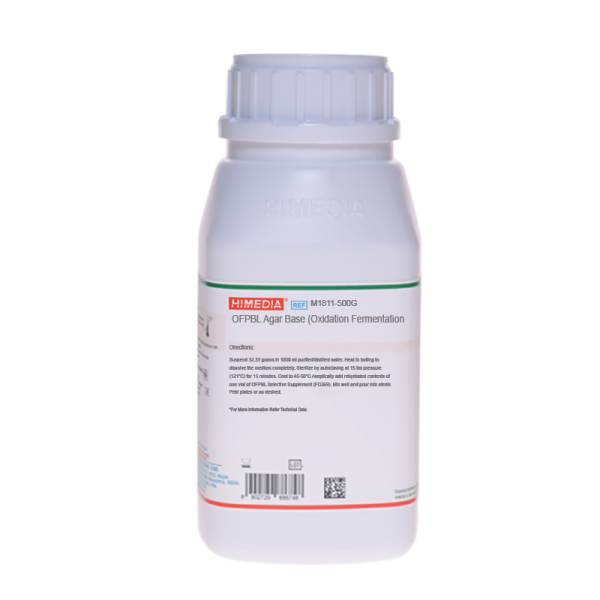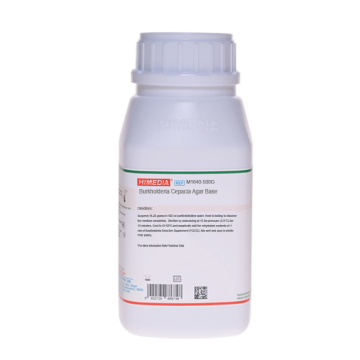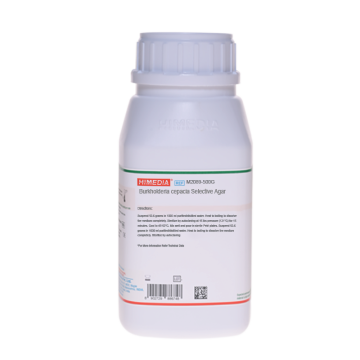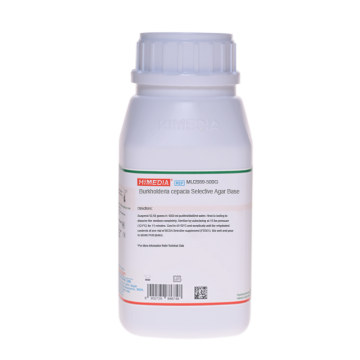 Your enquiry has been submitted
Your enquiry has been submitted
OFPBL Agar Base (Oxidation Fermentation Polymyxin Bacitracin Lactose Agar Base)
Intended Use
When supplemented with Polymyxin and Bacitracin it is recommended for the selective isolation of Burkholderia cepacia from clinical and non-clinical samples.
Composition**
| Ingredients | g / L |
|---|---|
| Tryptone | 2.000 |
| Dipotassium hydrogen phosphate | 0.300 |
| Sodium chloride | 5.000 |
| Lactose | 10.000 |
| Bromothymol blue | 0.030 |
| Agar | 15.000 |
Final pH ( at 25°C): 6.8±0.2
**Formula adjusted, standardized to suit performance parameters
Directions
Suspend 32.33 grams in 1000 ml purified/distilled water. Heat to boiling to dissolve the medium completely. Sterilize by autoclaving at 15 lbs pressure (121°C) for 15 minutes. Cool to 45-50°C Aseptically add rehydrated contents of one vial of OFPBL Selective Supplement (FD269). Mix well and pour into sterile Petri plates or as desired.
Principle And Interpretation
Burkholderia cepacia is an opportunistic pathogen generally associated with nosocomial infections. Due to its ability to survive for extended period of time in hostile environments, it is found in such widely varied and inhibitory items such as equipment, medications, mouthwash and disinfectants. Nosocomial infections caused by this organism include bacteremia, urinary infections, and respiratory infections. However, the most serious implication is when identified in patients with Cystic Fibrosis (CF) Patients with cystic fibrosis (CF) have a predisposition for infection and infected patients, if untreated, show a rapid decline in lung function, frequent bacteremia, and death due to lung failure. It is also reported to be a primary cause of bacteremia, pneumonia, and death in the Chronic granulomatous disease CGD patient population (1,2). Therefore, it is critical that isolation and proper identification be fast and accurate. Burkholderia Cepacia Agar (M1640) as well as OFPBL Agar (M1811) is recommended for isolation of Burkholderia cepacia from clinical specimens (1,3,4).
OFPBL medium is a modified version of OF (Oxidation Fermentation) basal medium developed by a group of researchers, Welch et al. in 1987 (5). They demonstrated that OFPBL agar resulted in improved recovery and isolation of Burkholderia cepacia when compared to other selective mediums such as MacConkey agar, XLD agar and various blood agars. OFPBL Agar contains the Tryptone which provides necessary nitrogenous compounds and lactose serves as carbohydrate source. Lactose is readily utilized by Burkholderia cepacia. The fermentation of lactose results in the release of acid end products which is detected by the pH indicator, bromothymol blue, present in the medium. When sufficient acid is produced the medium changes from green to yellow providing the colonies their yellow coloration. Dipotassium hydrogen phosphate in the medium buffers the medium well. Sodium chloride helps to maintain osmotic balance. The selectivity of the medium owes itself to the presence of the antibiotics polymixin B and bacitracin together these antibiotics provide good suppression of the bacterial flora present in respiratory secretions and sputum (for the inhibition of gram-positive organisms and Neisseria) (5).
Appropriate patient samples for testing include sputum, bronchial washings, and pharyngeal swabs. Using a direct or diluted inoculum from the sample, a four-quadrant streak may be performed to obtain well-isolated colonies. If the sample is collected on a swab, the swab may be rolled over a small area near the edge of the plate and further streaked for isolation using a sterile loop.
It is recommended to incubate at 30-35°C and examine the plates daily upto five days before discarding. Generally colonies develop within 48-72 hours.
Typically, Burkholderia cepacia colonies appear as yellow colonies with yellow halos. Most strains will grow in 48 hours but some strains may require up to 5 days for the color development. Most other microorganisms are inhibited on this medium. Other similar bacteria such as Pseudomonas aeruginosa may also grow as yellow colonies and further testing must be performed to differentiate these bacteria from Burkholderia cepacia. Burkholderia gladioli which has been shown to occur in respiratory tract specimens of CF patients will grow on OFPBL Agar and may resemble B.cepacia (6). Any growth is considered a positive result and additional biochemical and/or serological tests should be performed on isolated colonies from pure culture (1). The yellowing of the medium signifies carbohydrate fermentation and some rare, atypical strains of Burkholderia cepacia may not produce this reaction.
Type of specimen
Clinical samples - Sputum swabs.
Specimen Collection and Handling
For clinical samples follow appropriate techniques for handling specimens as per established guidelines (4,5). After use, contaminated materials must be sterilized by autoclaving before discarding.
Warning and Precautions
In Vitro diagnostic Use only. For professional use only. Read the label before opening the container. Wear protective gloves/protective clothing/eye protection/ face protection. Follow good microbiological lab practices while handling specimens and culture. Standard precautions as per established guidelines should be followed while handling clinical specimens. Safety guidelines may be referred in individual safety data sheets.
Limitations
- Similar bacteria such as Pseudomonas aeruginosa may also grow as yellow colonies and further testing must be performed to differentiate these bacteria from Burkholderia cepacia.
- Further biochemical and serological tests must be carried out for further identification.
Performance and Evaluation
Performance of the medium is expected when used as per the direction on the label within the expiry period when stored at recommended temperature.
Quality Control
Appearance Yellow to yellowish green coloured homogeneous free flowing powder
Gelling Firm, comparable with 1.5% Agar gel
Colour and Clarity of prepared medium Green coloured clear to slightly opalescent gel forms in Petri plates
Reaction Reaction of 3.23% w/v aqueous solution at 25°C. pH : 6.8±0.2
Cultural Response Cultural characteristics observed with added OFPBL Selective Supplement (FD269), after an incubation at 30-35°C for 48 - 72 hours. Examine upto five days.
| Organism | Inoculum (CFU) | Growth | Recovery | Colour of colony |
|---|---|---|---|---|
| Burkholderia cepacia ATCC 25416 | 50-100 | good-luxuriant | >=50% | yellow w/ yellow halo |
| Escherichia coli ATCC 25922 (00013*) | >=104 | inhibited | 0% | |
| Staphylococcus aureus subsp. aureus ATCC 25923 (00034*) | >=104 | inhibited | 0% |
Key : (*) Corresponding WDCM numbers.
Storage and Shelf Life
Store between 10-30°C in a tightly closed container and the prepared medium at 2-8°C. Use before expiry date on the label. On opening, product should be properly stored dry, after tightly capping the bottle in order to prevent lump formation due to the hygroscopic nature of the product. Improper storage of the product may lead to lump formation. Store in dry ventilated area protected from extremes of temperature and sources of ignition Seal the container tightly after use. Product performance is best if used within stated expiry period.
Disposal
User must ensure safe disposal by autoclaving and/or incineration of used or unusable preparations of this product. Follow established laboratory procedures in disposing of infectious materials and material that comes into contact with clinical sample must be decontaminated and disposed of in accordance with current laboratory techniques (4,5).
Reference
- Carson, L.A.et.al. 1988. J. Clin.Microbiol. 25:1730-1734.
- Christenson, J.C., et.al 1989. J. Clin. Microbiol.27: 270-273.
- Gilligan, P. H. and P. Vandamme, 2003. Misc. Gram Negative Bacteria, pp 729-748. In Murray, P. R., et al., Manual of Clinical Microbiology, 8th ed., American Society for Microbiology, Washington D.C., 2003.
- Isenberg, H.D. Clinical Microbiology Procedures Handbook 2nd Edition.
- Jorgensen, J.H., Pfaller, M.A., Carroll, K.C., Funke, G., Landry, M.L., Richter, S.S and Warnock., D.W. (2015) Manual of Clinical Microbiology, 11th Edition. Vol. 1.
| Product Name | OFPBL Agar Base (Oxidation Fermentation Polymyxin Bacitracin Lactose Agar Base) |
|---|---|
| SKU | M1811 |
| Product Type | Regular |
| Physical Form | Powder |
| Origin | Animal |
| Packaging type | HDPE |
| References | 1.Gilligan, P. H. and P. Vandamme, 200 |
| Customized Product Available | No |









